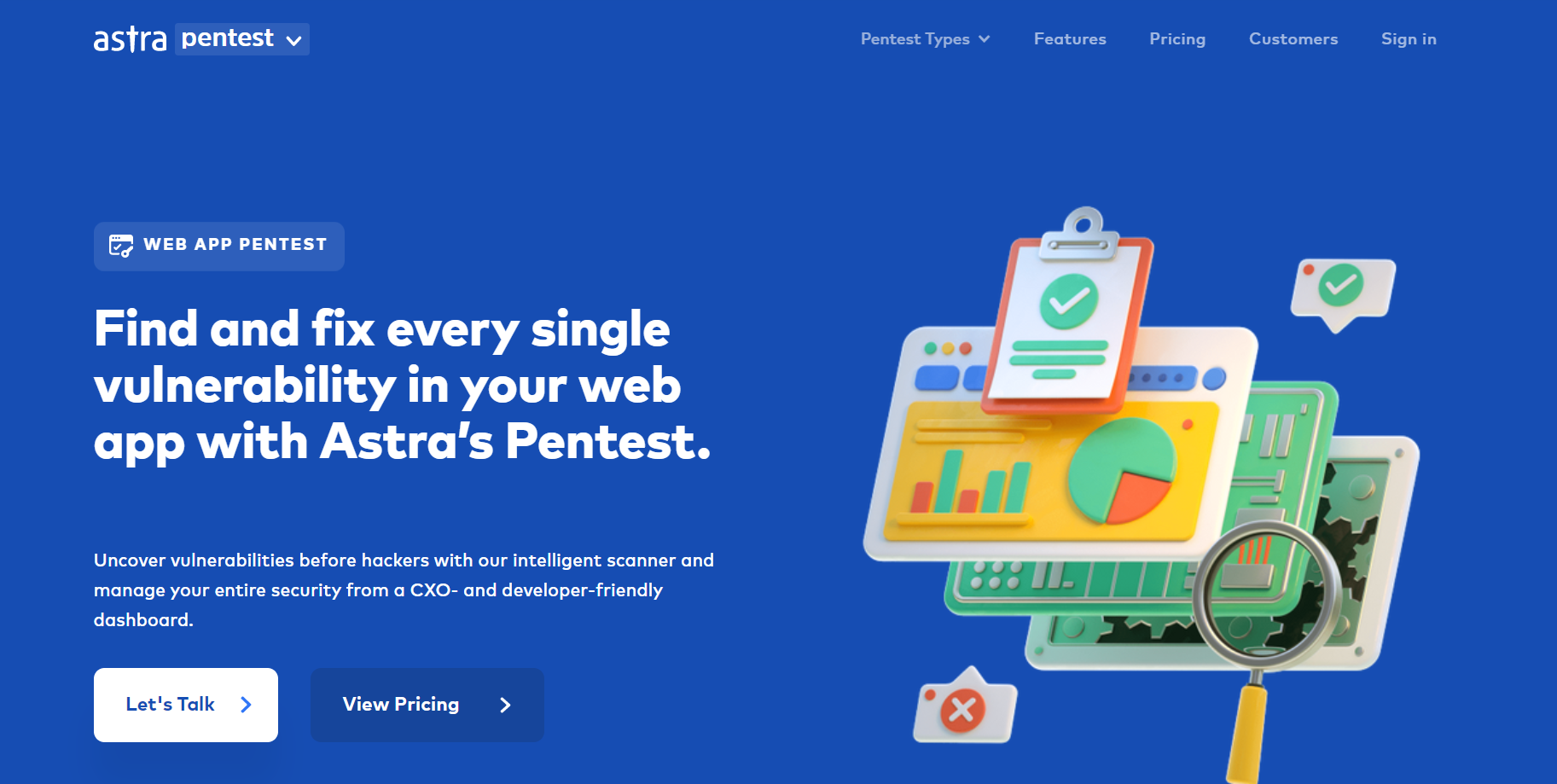Article Summary
This article explains what security weaknesses audits are, the top 5 tools as well as discuss the level of weaknesses, types and most commonly found risks in detail. Finally, it also discusses the various types of security weaknesses audits available according to one’s needs.
Security Weaknesses Audit
Security weaknesses audits are audits designed to find any and all weaknesses within a security system in order to fix them before they are exploited.
With over 8000 vulnerabilities and weaknesses being published just in the first quarter of 2022 alone, it comes as no surprise that security weaknesses audits are an avoidable need for companies.
Here are some of the best security audit tools you can consider when on the quest to conduct a security weaknesses audit:
Introduction
Security weaknesses audit not only help in the timely identification of weak spots within the security, but they also help in improving the security posture and in building a more security-conscious behavior.
Constantly improving one’s security, and remediating any weaknesses all make your organization a better choice for your potential customers owing to the perfection in the security of confidential data.
This article details the best security weakness audit tools along with their pros and cons, mentions the different types of vulnerabilities, and finally, the various types of security weaknesses audit available.
Best Security Weaknesses Audit Tools
1. Astra Pentest

One of the top-notch security weaknesses audit tools, Astra Pentest provides expert security audits with the assurance of zero false positives to find all the weak spots plaguing one’s security.
- Regular Pentests
Astra provides continuous hacker-style penetration tests to identify and exploit vulnerabilities through vulnerability scans. This helps organizations understand how an actual hack would affect their systems, network, and data.
- Continuous Vulnerability Assessment
Astra provides a continuous comprehensive vulnerability assessment of your networks to ensure that there are no vulnerabilities. If scans detect any vulnerabilities these are segregated based on their severity and explained in detail in the reports which can be used for remediation.
Also, Read Continuous Penetration Testing: The Best Tool You’ll Find
- Comprehensive Vulnerability Scanner
Astra Pentest provides a world-class comprehensive vulnerability scanner that is capable of finding vulnerabilities using NIST and OWASP methodologies. These vulnerabilities are identified based on known CVEs, OWASP Top 10, SANS 25, and intel from various reliable sources.
- Easy-To-Navigate Dashboard
With a total of ease of use and navigation, Astra’s dashboards win its customers over its great user experience. There are separate dashboards available for pentest and compliance making it easier for identifications and resolutions.
The dashboard displays the vulnerabilities found in real-time with the severity scores and provides an option of collaboration with the target’s development time for quicker smoother patching.
- Maintain Compliance
Astra helps maintain compliance with its compliance-specific scans for regulatory standards like PCI-DSS, SOC2, GDPR, ISO 27001, and HIPAA. Astra’s scans find areas of non-compliance based on the compliance standards you choose to scan for. This is important as your organization can stay compliant and avoid any hefty fines.
- Detailed Reports
Well-detailed reports are yet another alluring feature of Astra’s penetration testing services. These reports have the scope of testing explained, vulnerabilities found on scanning, methods employed for exploitation of vulnerabilities, and the damages and information revealed from exploiting them as well.
Based on this, the report also mentions the CVSS scores for these vulnerabilities and the detailed steps to take to patch them up. These reports are extremely useful for organizations when it comes to patching, or for documenting purposes for an audit.
- Pentest Certificate
Astra pentest certificate is a must-have and is only provided to customers who patch all the vulnerabilities found in the security weaknesses audit and obtain a rescan to ensure that there are no further vulnerabilities.
This certificate is publicly verifiable and can be displayed on customer websites to showcase its reliability and security-conscious nature. This brings about more customers who trust the services offered by your network.
- 24*7 Customer Care
Astra provides 24*7 expert assistance to its customers through e-mails, phone calls, and even the dashboard. Customers can touch with any queries they have regarding any vulnerabilities within the reply box under every vulnerability detected.
- Zero False Positive
Zero false positives are a sure thing with Astra’s thorough vetting which is done by expert pentesters based on the automated pentest results obtained. This double-checking, therefore, ensures that the customers don’t have to worry about any false positive vulnerability detection.
Pros
- Detailed and thorough reports
- Great remediation assistance
- Easy to use and navigate
- Budget-friendly
- Assures zero false positives with vetted scans.
Cons
- Could have more integrations.
2. Sprinto

Sprinto’s smart combination of technology and automation brings a new speed to security auditing where it’s done in mere weeks. Some of its features include a comprehensive compliance checklist and systems integration.
Sprinto’s does not require customer data access but rather works by just monitoring the system’s configurations. They provide live sessions that help your organization to construct an implementation plan much faster.
Pros
- Provides zero touch audits.
- Automated evidence collection.
- Live sessions to construct better security plans.
Cons
- Can be a bit difficult to navigate.
3. Symantec

Symantec’s cloud workload protection provides automated security measures and security audits. Symantec is a tool provided by Broadcom Inc. and provides other functions besides security weaknesses audits like firewalls and malware detectors.
Pros
- Provides end-point protection and threat detection.
- Has malware detection capabilities with the capacity for immediate remediation.
- Can be integrated within the CI/CD pipeline.
Cons
- A pricey solution that may not be feasible for small to medium-sized companies.
- Could provide better integration possibilities.
4. CyberOps

They are a reputed and experienced firm of auditors with understanding and experience on how to implement the best ISMS for one’s company. They provide strong framework management through accountability of ISMS schedules and routine audits to maintain improvement.
Conducts regular analysis and review of the information security management system in place to uphold compliance standards and efficiency.
Pros
- Provides security training services
- Regular analyses of security systems
- Provides vulnerability patch management
Cons
- Pricing is not mentioned.
Level Of Weaknesses
Security weaknesses are often prioritized or categorized based on their severity to the security of a system. This helps in prioritizing as the weaknesses with the highest severity can be fixed first.
In the case of security audit reports, weaknesses found are categorized based on two types:
- CVSS scores: These are Common Vulnerability Scoring System scores that categorize all the vulnerabilities regardless of their relevance.
- Actionable Risk Scores: These are scores provided by the companies based on which actions can be taken to fix the vulnerability or leave it as such if it is a low vulnerability.
These weaknesses are further divided into 3 levels:
- Low: (1-4) These vulnerabilities are of the least importance and can be left as such or can be fixed if possible.
- Medium: (5-7)These vulnerabilities need to be fixed, however only after the critical weaknesses are fixed.
- Critical: (8-10)These are the weaknesses within a security system that needs the highest attention, priority, and quick remediation as they are most prone to be exploited.
Different Types Of Security Weaknesses
Weaknesses or vulnerabilities can be categorized into mainly three types:
- Network Vulnerabilities
Weaknesses within a network like insecure wifi access points, poorly configured firewalls, and weak authentication measures are some examples of vulnerabilities that can plague a network’s hardware and or software.
- Operating System Vulnerabilities
These are weaknesses found within a particular operating system that can be used to gain access by hackers to cause damage or for theft like programs with hidden backdoors.
- Human Vulnerabilities
These refer to human errors that result in weaknesses like the implementation of weak passwords, the creation of exposed access points, and more.
Top Security Weaknesses Addressed In Audit
1. Injection Attack
Certain flaws or problematic areas of security go undetected during the coding phase of software development. This results in issues like SQL injections and or Cross-Site-Scripting (XSS) errors to be in the code that is written and deployed. Such malicious codes can also be purposefully placed with malicious intent. This in turn makes them susceptible to breaches through malware, ransomware, and more.
2. Malware
Malware is a security weakness that occurs by sending a malicious code of file that leads to the corruption of sensitive data and also results in the hackers gaining access to the targetted assets.
Different kinds of malware include:
- Trojan virus: These are viruses that are hidden within seemingly harmless files that escape detection but infect systems when downloaded.
- Spyware: Mostly used to infect phones, desktop applications, and browsers this type of malware allows attackers to gain access to private payment details and credentials.
3. Denial of Service
These are attacks that disrupt normal web traffic by temporarily disrupting its services by flooding it with fake or a large number of requests. The overwhelmed server shuts down and becomes unresponsive even to legitimate requests.
4. Phishing
Fake emails and other correspondence are sent from seemingly reliable sources requiring users to click or enter details that can be obtained to be used for malicious purposes. The main types of phishing attacks are:
- Spear-phishing: Spear phishing is similar to phishing but differs in the sense that these attacks are specifically targeted and catered to individuals with security privileges or certain sensitive information like administrators and executives.
- Whaling: This is another form of phishing where bigger targets (whales) like CEOs or CFOs are the intended victims of the trickery that leads them to divulge highly sensitive data.
5. Password Attack
Attackers aim to crack or guess at passwords in a random or systematic way using different methods. These methods include:
- Brute-force: In this type of password attack, attackers use different software designed to use logic-related assumptions for the passwords.
- Dictionary attack: In this, the attacker tries a known list of possible passwords or regularly used passwords and their variations.
Types of Security Weaknesses Audits
1. Web Security Audit
Security weaknesses audit for web applications helps identify vulnerabilities and loopholes within them before they are exploited. This staves off various kinds of threats like DDoS attacks, and can even help find business logic errors. The front end of a website gets tested and all aspects of it including extensions and themes are assessed too.
2. Network Security Audit
Network security forms a crucial cog in the wheel of IT security. Such security audits carry relevance as networks usually see high activity in terms of data transfers and storage.
3. Cloud Security Audit
Cloud security weaknesses audits are carried out on the cloud servers where copious amounts of data and applications are stored and transmitted making it vital to ensure that the cloud server providers carry out regular audits to make sure that all vulnerabilities have been found and fixed.
4. Mobile Security Audit
This refers to auditing applications that are built specifically for mobile devices. This is crucial since nearly everyone everywhere makes use of phones and has a lot of data stored in them. It is a responsibility to integrate security audits into the development pipeline of an application thus ensuring its safety from data theft or deletion.
5. API Security Audits
API security weaknesses audits refer to auditing, pentesting, or assessing APIs for any vulnerabilities. Web services are also a type of API that can be audited. Insecure APIs make for excellent targets for hackers.
6. Compliance Security Audits
This particular security weaknesses audit service aims to ensure and enforce an organization’s continuous compliance with industry-standard or even the company’s own set of rules and regulations. They ensure that organizations are PCI-DSS, HIPAA, or SOC2 and ISO 27001 compliant depending on whichever is applicable to the organization.
Checkout: Comprehensive Theme VAPT
Conclusion
Security weaknesses audits are an essential part of maintaining a good security posture. Key to avoiding any weaknesses that can cause major disruptions in a working environment, this article has mentioned the best tools to consider for your security weaknesses audit needs like Astra Pentest. Choose the right audit provider for you today to maintain the holistic security of your organization!
FAQs
What are the different types of security weaknesses audits?
There are two types of security weaknesses audits:
1. Internal Audits: These are audits done within the company by themselves using their audit department and internal resources.
2. External Audits: These are security audits conducted by an external security auditor.
What does a security audit include?
A security audit includes steps like-
1. Defining the scope of a security audit.
2. Scanning the assets decided on in the scope.
3. Evaluating the risks found during the scan to prioritize them.
4. Generation of the audit report with findings and remediation measures.
5. Remediation of weaknesses found based on the report.
What is the focus of a security audit?
A security audit focuses on assessing the security of an organization based on certain benchmark criteria off of a checklist of compliance requirements, best practices, methodologies, and security guidelines.
















